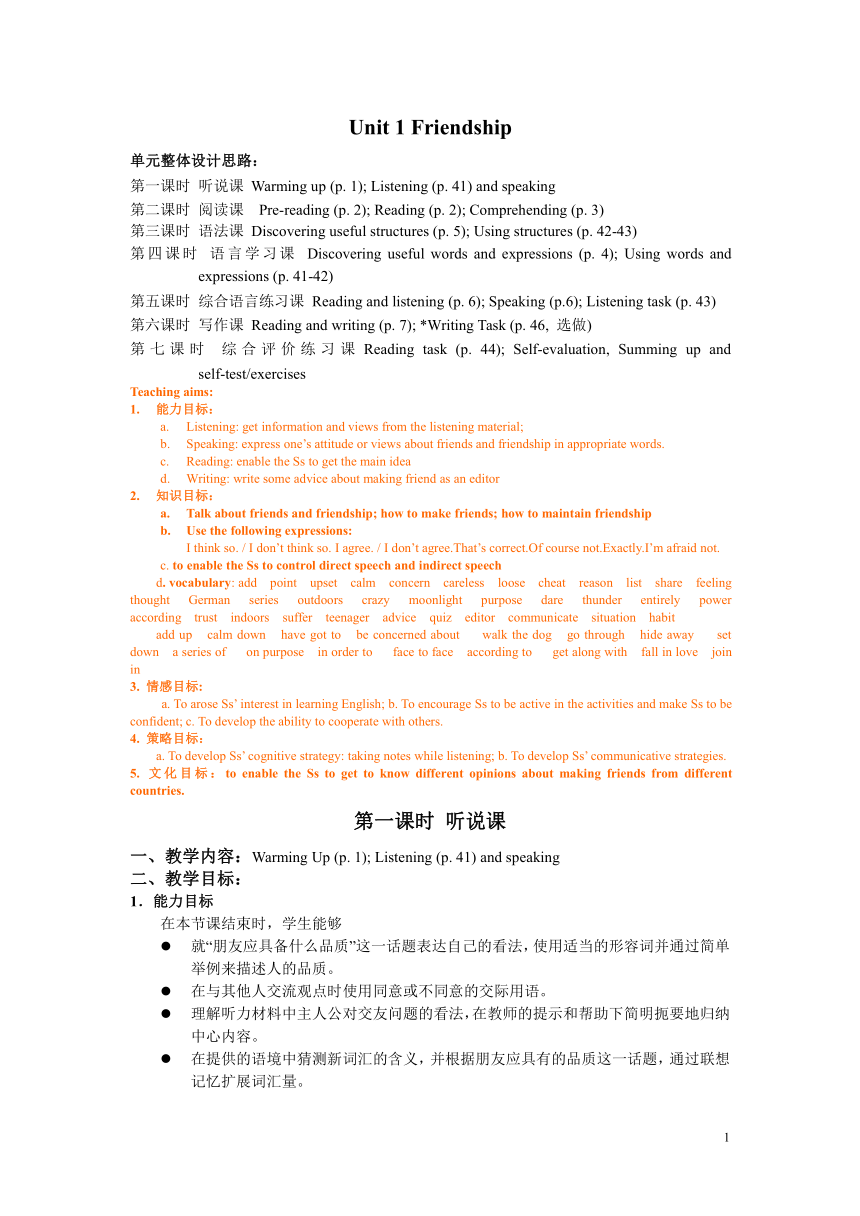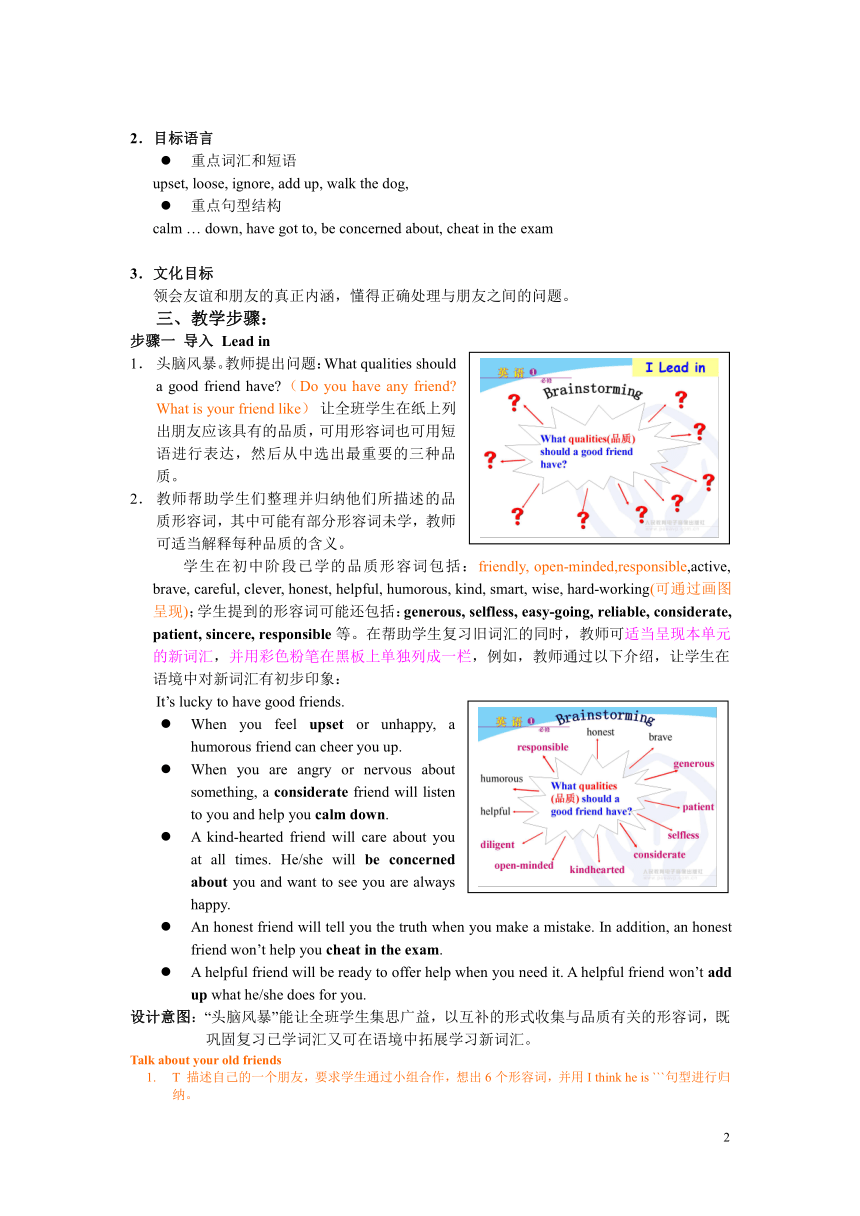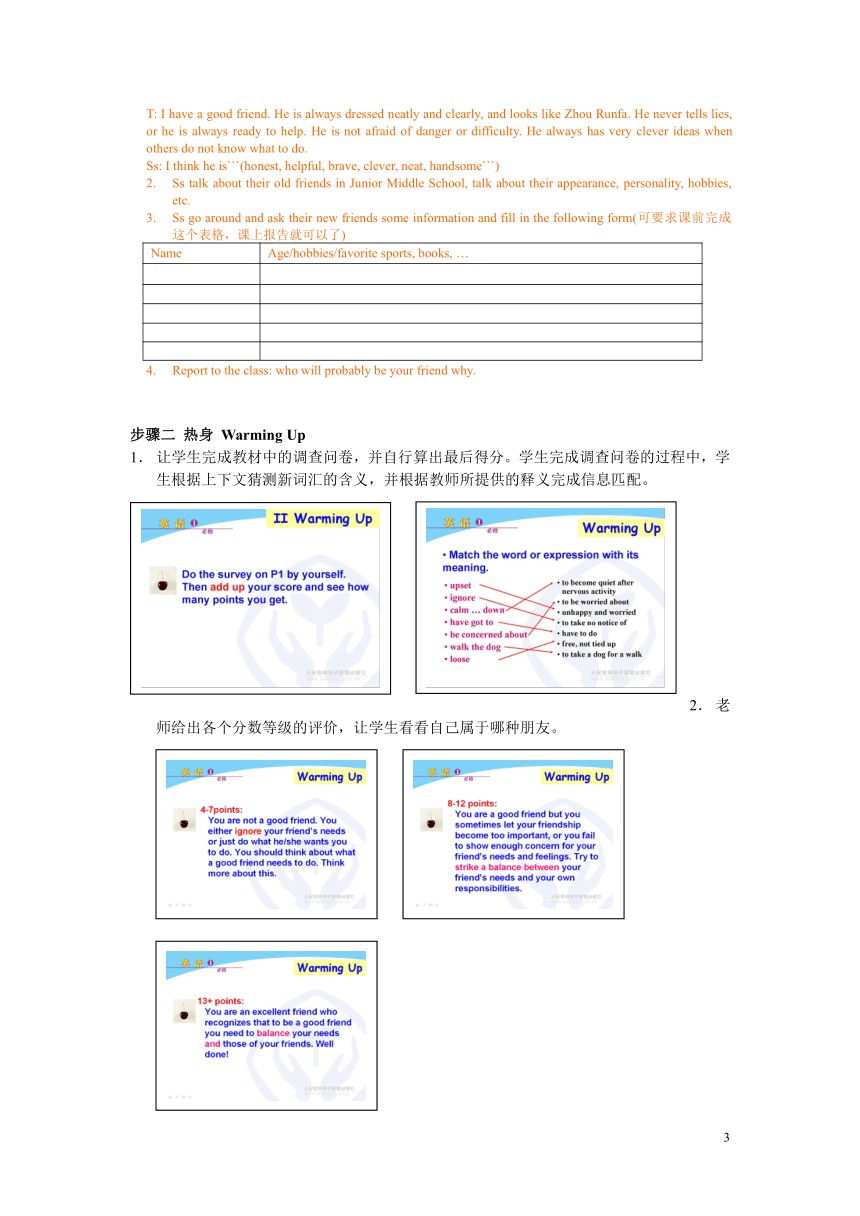Unit1 Friengship Period 1
文档属性
| 名称 | Unit1 Friengship Period 1 |  | |
| 格式 | zip | ||
| 文件大小 | 6.4MB | ||
| 资源类型 | 教案 | ||
| 版本资源 | 人教版(新课程标准) | ||
| 科目 | 英语 | ||
| 更新时间 | 2012-09-07 17:15:27 | ||
图片预览



文档简介
Unit 1 Friendship
单元整体设计思路:
第一课时 听说课 Warming up (p. 1); Listening (p. 41) and speaking
第二课时 阅读课 Pre-reading (p. 2); Reading (p. 2); Comprehending (p. 3)
第三课时 语法课 Discovering useful structures (p. 5); Using structures (p. 42-43)
第四课时 语言学习课 Discovering useful words and expressions (p. 4); Using words and expressions (p. 41-42)
第五课时 综合语言练习课 Reading and listening (p. 6); Speaking (p.6); Listening task (p. 43)
第六课时 写作课 Reading and writing (p. 7); *Writing Task (p. 46, 选做)
第七课时 综合评价练习课Reading task (p. 44); Self-evaluation, Summing up and self-test/exercises
Teaching aims:
能力目标:
Listening: get information and views from the listening material;
Speaking: express one’s attitude or views about friends and friendship in appropriate words.
Reading: enable the Ss to get the main idea
Writing: write some advice about making friend as an editor
知识目标:
Talk about friends and friendship; how to make friends; how to maintain friendship
Use the following expressions:
I think so. / I don’t think so. I agree. / I don’t agree.That’s correct.Of course not.Exactly.I’m afraid not.
c. to enable the Ss to control direct speech and indirect speech
d. vocabulary: add point upset calm concern careless loose cheat reason list share feeling thought German series outdoors crazy moonlight purpose dare thunder entirely power according trust indoors suffer teenager advice quiz editor communicate situation habit
add up calm down have got to be concerned about walk the dog go through hide away set down a series of on purpose in order to face to face according to get along with fall in love join in
3. 情感目标:
a. To arose Ss’ interest in learning English; b. To encourage Ss to be active in the activities and make Ss to be confident; c. To develop the ability to cooperate with others.
4. 策略目标:
a. To develop Ss’ cognitive strategy: taking notes while listening; b. To develop Ss’ communicative strategies.
5. 文化目标:to enable the Ss to get to know different opinions about making friends from different countries.
第一课时 听说课
一、教学内容:Warming Up (p. 1); Listening (p. 41) and speaking
二、教学目标:
1.能力目标
在本节课结束时,学生能够
就“朋友应具备什么品质”这一话题表达自己的看法,使用适当的形容词并通过简单举例来描述人的品质。
在与其他人交流观点时使用同意或不同意的交际用语。
理解听力材料中主人公对交友问题的看法,在教师的提示和帮助下简明扼要地归纳中心内容。
在提供的语境中猜测新词汇的含义,并根据朋友应具有的品质这一话题,通过联想记忆扩展词汇量。
2.目标语言
重点词汇和短语
upset, loose, ignore, add up, walk the dog,
重点句型结构
calm … down, have got to, be concerned about, cheat in the exam
3.文化目标
领会友谊和朋友的真正内涵,懂得正确处理与朋友之间的问题。
三、教学步骤:
步骤一 导入 Lead in
头脑风暴。教师提出问题:What qualities should a good friend have (Do you have any friend What is your friend like) 让全班学生在纸上列出朋友应该具有的品质,可用形容词也可用短语进行表达,然后从中选出最重要的三种品质。
教师帮助学生们整理并归纳他们所描述的品质形容词,其中可能有部分形容词未学,教师可适当解释每种品质的含义。
学生在初中阶段已学的品质形容词包括:friendly, open-minded,responsible,active, brave, careful, clever, honest, helpful, humorous, kind, smart, wise, hard-working(可通过画图呈现);学生提到的形容词可能还包括:generous, selfless, easy-going, reliable, considerate, patient, sincere, responsible等。在帮助学生复习旧词汇的同时,教师可适当呈现本单元的新词汇,并用彩色粉笔在黑板上单独列成一栏,例如,教师通过以下介绍,让学生在语境中对新词汇有初步印象:
It’s lucky to have good friends.
When you feel upset or unhappy, a humorous friend can cheer you up.
When you are angry or nervous about something, a considerate friend will listen to you and help you calm down.
A kind-hearted friend will care about you at all times. He/she will be concerned about you and want to see you are always happy.
An honest friend will tell you the truth when you make a mistake. In addition, an honest friend won’t help you cheat in the exam.
A helpful friend will be ready to offer help when you need it. A helpful friend won’t add up what he/she does for you.
设计意图:“头脑风暴”能让全班学生集思广益,以互补的形式收集与品质有关的形容词,既巩固复习已学词汇又可在语境中拓展学习新词汇。
Talk about your old friends
T 描述自己的一个朋友,要求学生通过小组合作,想出6个形容词,并用I think he is ```句型进行归纳。
T: I have a good friend. He is always dressed neatly and clearly, and looks like Zhou Runfa. He never tells lies, or he is always ready to help. He is not afraid of danger or difficulty. He always has very clever ideas when others do not know what to do.
Ss: I think he is```(honest, helpful, brave, clever, neat, handsome```)
Ss talk about their old friends in Junior Middle School, talk about their appearance, personality, hobbies, etc.
Ss go around and ask their new friends some information and fill in the following form(可要求课前完成这个表格,课上报告就可以了)
Name Age/hobbies/favorite sports, books, …
Report to the class: who will probably be your friend why.
步骤二 热身 Warming Up
让学生完成教材中的调查问卷,并自行算出最后得分。学生完成调查问卷的过程中,学生根据上下文猜测新词汇的含义,并根据教师所提供的释义完成信息匹配。
老师给出各个分数等级的评价,让学生看看自己属于哪种朋友。
教师可启发学生利用步骤一所收集的词汇对调查问卷的每个问题进行小结和归纳:What can we learn from each question A friend should be ___________.
然后教师给予总结:
Q1: A friend should be helpful.
Q2: A friend should be generous.
Q3: A friend should be kind-hearted and concerned about you.
Q4: A friend should be responsible.
Q5: A friend should be honest.
设计意图:通过让学生完成调查问卷来进行自我检测,自测属于哪类朋友,目的是让学生思考应该如何处理朋友间的问题和如何成为一个真正的好朋友。完成问卷的同时也给予学生机会在语境中学习词汇。老师最后的点评给了学生明确的指引,如何正确地处理这五种情况。同时,再次巩固与品质相关的词汇。
4.补充(对话):
---what would you do when I have no money to buy the book
---I would lend you some.
---what would you do when I can’t do the homework
---I would help you with it.
步骤三 听力 Listening
1.听力任务一
1)听前:让学生看图,观察图中人物的行为和表情,分析两人的关系以及谈论的内容。
2)听录音,让学生用一句话来表述听力材料的中心内容,完成练习1和练习2中的第一题。
学生先阅读练习2中的问题,然后再次听录音,听的过程中必须记笔记。
最后放一次录音,检查练习答案。
2.听力任务二
老师引出话题,让学生两人小组回答下列问题。回答后两个问题时,学生要利用教师所提供的关于表达看法的交际用语表述自己的观点。
2)教师选取学生汇报自己的看法,收集并归纳学生关于“和外国人交朋友有什么好处”的观点。
3)学生听录音,完成练习2。教师以提问的形式帮助学生用一句话归纳Leslie在中国做什么工作。ask them to take notes about the speaker’s views of making friends.
学生听第一部分录音材料,完成练习3。
5)学生听第二部分录音材料,以提问的形式给予学生提示,帮助其完成练习4。
设计意图:听前,让学生讨论与听力材料相关的话题,有利于学生熟悉将要听到的内容,做好听的准备。此听力材料难度不大,但是练习题的考察难度稍大,要求学生有较高的概括能力,因此适当修改了练习并且设计了几个简单问题来引导学生完成。
步骤四 说Speaking
集体讨论
向全班提出供讨论的问题:朋友一定是人吗?动物或其他东西可以成为我们的朋友吗?
让学生在班里自由发表意见,教师将学生们的答案列在黑板上。
2. 小组讨论
1)把学生分成四人讨论小组,展开讨论:你会把日 记当作你的朋友吗?
2)老师提供表达同意和不同意的交际用语,并提醒 学生在讨论过程中使用。
3)老师选择几个小组发表自己的意见,要求学生使用适当的交际用语,并给予适当的评价或纠正。
设计意图:引出讨论话题是为了下一节阅读课做铺垫,也为学生提供了交流的空间。通过口语交际活动,让学生学习和运用英语语言来发表自己的看法和观点,表达同意还是不同意。
步骤五 小结和作业
1.提出两个问题,帮助学生回顾和总结本节课所学的有关品质的词汇以及表达同意和不同意的表达用语。
2.让学生听录音带,预习本单元阅读篇章中的单词和词组(参照单词表)。
3.根据 (p. 45)Speaking Task回答相关问题。
4.让学生课后搜集第二次世界大战中有关犹太人遭受迫害的背景材料。
设计意图:学生只有掌握好了阅读文章的生词,才能为阅读和理解奠定好基础;要求学生课后利用互联网、图书馆等渠道搜集有关第二次世界大战中犹太人遭受迫害的背景材料,可帮助他们理解下节课即将学习的课文。让学生就Speaking Task课后进行两人做对话,为训练本单元功能意念项目——同意和不同意做铺垫。
Sep 5. Listening and talking
Do Wb P41 (Listening and Talking). While Ss listen to the material, ask them to take notes about the speaker’s views of making friends.
When Ss make their conversation, ask them to try to use the following expressions.
I think so. / I don’t think so. I agree. / I don’t agree.
That’s correct. Of course not. Exactly. I’m afraid not. (P6)
Step 6. Discussion
Divide Ss four in one group and each group choose a topic to discuss. There are four topics.
Topic 1: Why do you need friends Make a list of reasons why friends are important to you.
Topic 2: There is a saying “to have a good friend, you need to be a good friend.” What do you think of the saying and how can you be a good friend
Topic 3: Does a friend always have to be a person What else can be your friend Why
Topic 4: List some qualities of a person who does not make friend easily.
Step 7. Summary
Ask Ss themselves to summarize what is friendship and what is the most important in making friends.
T shows more information about friendship and a poem about friendship.
What is friendship
3. Tell Ss: make new friends and keep the old; one is silver and the other is gold.
Step 8. Evaluation
Ss finish the following evaluation form. Standard: A, B,C
Contents 自评 他评
1. I’m active in talking with others.
2. I’m active in cooperating with others.
3.I can express myself fluently, accurately and appropriately.
4. I know more about friendship after this lesson..
5. Do you think you need to improve yourself in some aspects Which aspects
Homework:
Look up the new words and expressions in warm-up and pre-reading in a dictionary.
Write a short passage about your best friend.
PAGE
7
单元整体设计思路:
第一课时 听说课 Warming up (p. 1); Listening (p. 41) and speaking
第二课时 阅读课 Pre-reading (p. 2); Reading (p. 2); Comprehending (p. 3)
第三课时 语法课 Discovering useful structures (p. 5); Using structures (p. 42-43)
第四课时 语言学习课 Discovering useful words and expressions (p. 4); Using words and expressions (p. 41-42)
第五课时 综合语言练习课 Reading and listening (p. 6); Speaking (p.6); Listening task (p. 43)
第六课时 写作课 Reading and writing (p. 7); *Writing Task (p. 46, 选做)
第七课时 综合评价练习课Reading task (p. 44); Self-evaluation, Summing up and self-test/exercises
Teaching aims:
能力目标:
Listening: get information and views from the listening material;
Speaking: express one’s attitude or views about friends and friendship in appropriate words.
Reading: enable the Ss to get the main idea
Writing: write some advice about making friend as an editor
知识目标:
Talk about friends and friendship; how to make friends; how to maintain friendship
Use the following expressions:
I think so. / I don’t think so. I agree. / I don’t agree.That’s correct.Of course not.Exactly.I’m afraid not.
c. to enable the Ss to control direct speech and indirect speech
d. vocabulary: add point upset calm concern careless loose cheat reason list share feeling thought German series outdoors crazy moonlight purpose dare thunder entirely power according trust indoors suffer teenager advice quiz editor communicate situation habit
add up calm down have got to be concerned about walk the dog go through hide away set down a series of on purpose in order to face to face according to get along with fall in love join in
3. 情感目标:
a. To arose Ss’ interest in learning English; b. To encourage Ss to be active in the activities and make Ss to be confident; c. To develop the ability to cooperate with others.
4. 策略目标:
a. To develop Ss’ cognitive strategy: taking notes while listening; b. To develop Ss’ communicative strategies.
5. 文化目标:to enable the Ss to get to know different opinions about making friends from different countries.
第一课时 听说课
一、教学内容:Warming Up (p. 1); Listening (p. 41) and speaking
二、教学目标:
1.能力目标
在本节课结束时,学生能够
就“朋友应具备什么品质”这一话题表达自己的看法,使用适当的形容词并通过简单举例来描述人的品质。
在与其他人交流观点时使用同意或不同意的交际用语。
理解听力材料中主人公对交友问题的看法,在教师的提示和帮助下简明扼要地归纳中心内容。
在提供的语境中猜测新词汇的含义,并根据朋友应具有的品质这一话题,通过联想记忆扩展词汇量。
2.目标语言
重点词汇和短语
upset, loose, ignore, add up, walk the dog,
重点句型结构
calm … down, have got to, be concerned about, cheat in the exam
3.文化目标
领会友谊和朋友的真正内涵,懂得正确处理与朋友之间的问题。
三、教学步骤:
步骤一 导入 Lead in
头脑风暴。教师提出问题:What qualities should a good friend have (Do you have any friend What is your friend like) 让全班学生在纸上列出朋友应该具有的品质,可用形容词也可用短语进行表达,然后从中选出最重要的三种品质。
教师帮助学生们整理并归纳他们所描述的品质形容词,其中可能有部分形容词未学,教师可适当解释每种品质的含义。
学生在初中阶段已学的品质形容词包括:friendly, open-minded,responsible,active, brave, careful, clever, honest, helpful, humorous, kind, smart, wise, hard-working(可通过画图呈现);学生提到的形容词可能还包括:generous, selfless, easy-going, reliable, considerate, patient, sincere, responsible等。在帮助学生复习旧词汇的同时,教师可适当呈现本单元的新词汇,并用彩色粉笔在黑板上单独列成一栏,例如,教师通过以下介绍,让学生在语境中对新词汇有初步印象:
It’s lucky to have good friends.
When you feel upset or unhappy, a humorous friend can cheer you up.
When you are angry or nervous about something, a considerate friend will listen to you and help you calm down.
A kind-hearted friend will care about you at all times. He/she will be concerned about you and want to see you are always happy.
An honest friend will tell you the truth when you make a mistake. In addition, an honest friend won’t help you cheat in the exam.
A helpful friend will be ready to offer help when you need it. A helpful friend won’t add up what he/she does for you.
设计意图:“头脑风暴”能让全班学生集思广益,以互补的形式收集与品质有关的形容词,既巩固复习已学词汇又可在语境中拓展学习新词汇。
Talk about your old friends
T 描述自己的一个朋友,要求学生通过小组合作,想出6个形容词,并用I think he is ```句型进行归纳。
T: I have a good friend. He is always dressed neatly and clearly, and looks like Zhou Runfa. He never tells lies, or he is always ready to help. He is not afraid of danger or difficulty. He always has very clever ideas when others do not know what to do.
Ss: I think he is```(honest, helpful, brave, clever, neat, handsome```)
Ss talk about their old friends in Junior Middle School, talk about their appearance, personality, hobbies, etc.
Ss go around and ask their new friends some information and fill in the following form(可要求课前完成这个表格,课上报告就可以了)
Name Age/hobbies/favorite sports, books, …
Report to the class: who will probably be your friend why.
步骤二 热身 Warming Up
让学生完成教材中的调查问卷,并自行算出最后得分。学生完成调查问卷的过程中,学生根据上下文猜测新词汇的含义,并根据教师所提供的释义完成信息匹配。
老师给出各个分数等级的评价,让学生看看自己属于哪种朋友。
教师可启发学生利用步骤一所收集的词汇对调查问卷的每个问题进行小结和归纳:What can we learn from each question A friend should be ___________.
然后教师给予总结:
Q1: A friend should be helpful.
Q2: A friend should be generous.
Q3: A friend should be kind-hearted and concerned about you.
Q4: A friend should be responsible.
Q5: A friend should be honest.
设计意图:通过让学生完成调查问卷来进行自我检测,自测属于哪类朋友,目的是让学生思考应该如何处理朋友间的问题和如何成为一个真正的好朋友。完成问卷的同时也给予学生机会在语境中学习词汇。老师最后的点评给了学生明确的指引,如何正确地处理这五种情况。同时,再次巩固与品质相关的词汇。
4.补充(对话):
---what would you do when I have no money to buy the book
---I would lend you some.
---what would you do when I can’t do the homework
---I would help you with it.
步骤三 听力 Listening
1.听力任务一
1)听前:让学生看图,观察图中人物的行为和表情,分析两人的关系以及谈论的内容。
2)听录音,让学生用一句话来表述听力材料的中心内容,完成练习1和练习2中的第一题。
学生先阅读练习2中的问题,然后再次听录音,听的过程中必须记笔记。
最后放一次录音,检查练习答案。
2.听力任务二
老师引出话题,让学生两人小组回答下列问题。回答后两个问题时,学生要利用教师所提供的关于表达看法的交际用语表述自己的观点。
2)教师选取学生汇报自己的看法,收集并归纳学生关于“和外国人交朋友有什么好处”的观点。
3)学生听录音,完成练习2。教师以提问的形式帮助学生用一句话归纳Leslie在中国做什么工作。ask them to take notes about the speaker’s views of making friends.
学生听第一部分录音材料,完成练习3。
5)学生听第二部分录音材料,以提问的形式给予学生提示,帮助其完成练习4。
设计意图:听前,让学生讨论与听力材料相关的话题,有利于学生熟悉将要听到的内容,做好听的准备。此听力材料难度不大,但是练习题的考察难度稍大,要求学生有较高的概括能力,因此适当修改了练习并且设计了几个简单问题来引导学生完成。
步骤四 说Speaking
集体讨论
向全班提出供讨论的问题:朋友一定是人吗?动物或其他东西可以成为我们的朋友吗?
让学生在班里自由发表意见,教师将学生们的答案列在黑板上。
2. 小组讨论
1)把学生分成四人讨论小组,展开讨论:你会把日 记当作你的朋友吗?
2)老师提供表达同意和不同意的交际用语,并提醒 学生在讨论过程中使用。
3)老师选择几个小组发表自己的意见,要求学生使用适当的交际用语,并给予适当的评价或纠正。
设计意图:引出讨论话题是为了下一节阅读课做铺垫,也为学生提供了交流的空间。通过口语交际活动,让学生学习和运用英语语言来发表自己的看法和观点,表达同意还是不同意。
步骤五 小结和作业
1.提出两个问题,帮助学生回顾和总结本节课所学的有关品质的词汇以及表达同意和不同意的表达用语。
2.让学生听录音带,预习本单元阅读篇章中的单词和词组(参照单词表)。
3.根据 (p. 45)Speaking Task回答相关问题。
4.让学生课后搜集第二次世界大战中有关犹太人遭受迫害的背景材料。
设计意图:学生只有掌握好了阅读文章的生词,才能为阅读和理解奠定好基础;要求学生课后利用互联网、图书馆等渠道搜集有关第二次世界大战中犹太人遭受迫害的背景材料,可帮助他们理解下节课即将学习的课文。让学生就Speaking Task课后进行两人做对话,为训练本单元功能意念项目——同意和不同意做铺垫。
Sep 5. Listening and talking
Do Wb P41 (Listening and Talking). While Ss listen to the material, ask them to take notes about the speaker’s views of making friends.
When Ss make their conversation, ask them to try to use the following expressions.
I think so. / I don’t think so. I agree. / I don’t agree.
That’s correct. Of course not. Exactly. I’m afraid not. (P6)
Step 6. Discussion
Divide Ss four in one group and each group choose a topic to discuss. There are four topics.
Topic 1: Why do you need friends Make a list of reasons why friends are important to you.
Topic 2: There is a saying “to have a good friend, you need to be a good friend.” What do you think of the saying and how can you be a good friend
Topic 3: Does a friend always have to be a person What else can be your friend Why
Topic 4: List some qualities of a person who does not make friend easily.
Step 7. Summary
Ask Ss themselves to summarize what is friendship and what is the most important in making friends.
T shows more information about friendship and a poem about friendship.
What is friendship
3. Tell Ss: make new friends and keep the old; one is silver and the other is gold.
Step 8. Evaluation
Ss finish the following evaluation form. Standard: A, B,C
Contents 自评 他评
1. I’m active in talking with others.
2. I’m active in cooperating with others.
3.I can express myself fluently, accurately and appropriately.
4. I know more about friendship after this lesson..
5. Do you think you need to improve yourself in some aspects Which aspects
Homework:
Look up the new words and expressions in warm-up and pre-reading in a dictionary.
Write a short passage about your best friend.
PAGE
7
